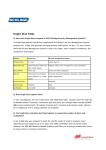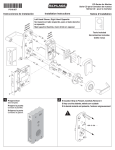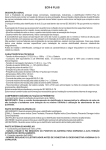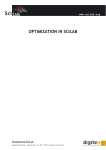Download Panel Interface Board
Transcript
*P516-097* P516-097 PIB300 and PIB301 User Guide Installation and operation instructions for Panel Interface Board Para el idioma español, navegue hacia www.schlage.com/support Pour la portion française, veuillez consulter le site www.schlage.com/support Contents Overview............................................................................................................................3 Getting started...................................................................................................................3 Handheld device (HHD).....................................................................................................4 PIB300/PIB301 installation................................................................................................4 Location.........................................................................................................................4 Wiring to the lock...........................................................................................................4 Connect the PIB300/PIB301 to the access control panel (ACP)................................... 4 Cable/wire specifications...............................................................................................5 Typical wiring to the access control panel......................................................................5 PIB300/PIB301 to ACP connection...................................................................................6 Complete the installation...................................................................................................8 Access point ACP connections to a RS-485 device address ........................................8 Reset to factory defaults....................................................................................................8 FCC statements.................................................................................................................8 This product is compliant of UL 294 and ULC S319 standard. This product’s compliance would be invalidated through the use of any add-on, expansion, memory or other module that has not yet been evaluated for compatibility for use with this UL Listed product, in accordance with the requirements of the Standards UL 294 and ULC S319. This product has been evaluated for ULC-S319 Class I. 2 • Schlage • PIB300 / PIB301 user guide Overview The Schlage Panel Interface Board (PIB300 or PIB301) provides a means of connecting RS485 based access point devices to a system requiring wiegand or clock and data protocol (rather than direct RS-485 connection). This manual describes the installation and operation of the PIB300/PIB301. • Open architecture platform • The Schlage PIB301 provides a means of connecting the FIPS-201 certified AD-301 to an access control system via Wiegand protocol • Provides two-way communication with locks via a RS-485 connection • The PIB300 may connect up to two Schlage AD-300 locks or up to two RS-485 based legacy locks communicating with the RSI or VIP protocol, may connect to an Access Control Panel (ACP) or reader interface board • The PIB301 may connect up to two Schlage AD-301 locks to an ACP or reader interface board via wiegand protocol • Legacy and AD-300 locks may not both be present on the PIB300’s RS-485 connection • The trouble signal output will change state when the Anti-Tamper Switch (ATS) signals that the PIB300/PIB301 enclosure lid is open, or if an access point device indicates trouble status. Before installing a Schlage AD-Series system, read all documentation for all products in the installation. Access Control Panel Wiegand or Clock & Data for PIB300 Wiegand only for PIB301 PIB300 PIB301 RS485 AD-300 AD-301 Getting started The following is an overview of the steps required for setting up the PIB300/PIB301. • Install the lock. See the installation guide that came with the lock, or visit www.schlage.com/support for more information. • Use proper wiring to the PIB300/PIB301. See Cable/wire specifications on page 5 for more information. • Disconnect power to the lock and Access Control Panel (ACP) while connecting the PIB300/PIB301. • Familiarize yourself with the information in this user guide. Save this user guide for future reference. Customer Service 1-877-671-7011 www.allegion.com/us 3 Handheld device (HHD) The Handheld Device (HHD) is used for programming and setup only. The HHD is used to configure this device’s links and outputs. For information about the HHD, see the SUS user guide. PIB300/PIB301 installation Location • The PIB300/PIB301 should be located close to the access control panel (wiring distance may be up to 500 feet (152 meters)). Wiring to the lock • Power wire for locks must be appropriately sized for the distance and voltage. • Communication wire should be suitable for use on RS-485 type networks. • The maximum length of the RS-485 wiring from the PIB300/PIB301 to lock 2 is 4000 feet (1219 meters). • Wiring of locks requires one connector via the RS-485 connector (J5). • Connections from lock to lock should be daisy-chained (see diagram below). • The power supply is located at or near the PIB300/PIB301 for short wire runs, or local to locks if located far from the panel. PIB300 PIB301 RS485 Lock 1 ACP Lock 2 Daisy Chain Connect the PIB300/PIB301 to the access control panel (ACP) CAUTION: Disconnect the ACP power and batteries while wiring the PIB300 /PIB301 to the panel. WARNING: Because every access control panel is different, always check the panel’s instruction manual for appropriate interface wiring. • For compliance with UL 294, product must be used with a UL 294 Listed access control panel or unit. For compliance with ULC S319, product must be used with a ULC S319 Listed access control panel or unit. • Must be connected to external power using a UL294 listed power supply for UL installations, and a power supply that complies with CAN/ULC-S318 or CAN/ULC-S319 for cUL installations. The power supply must be capable of sourcing 250mA @ 12 or 24 VDC (example: Schlage PS902, PS904, PS906). Refer to Typical wiring to the access control panel on page 5 for how to connect DC power to the PIB300/PIB301. • Use shielded cables for the signal wiring between the PIB300/PIB301 and the ACP. For maximum wire lengths and cable specifications, sSee Cable/wire specifications on page 5 for more information.. 4 • Schlage • PIB300 / PIB301 user guide Cable/wire specifications Application DC power input RS-485 PIB300/ PIB301 to ACP Part number Belden 8760 or equivalent Belden 9841, 9842 or equivalent Alpha 1298C or equivalent AWG Description 18 2 conductor 24 22 Max run length 1000 feet (305 meters) 4000 feet (1219 meters) 500 feet (152 meters) 2 or 4 conductor shielded 8 conductor shielded Typical wiring to the access control panel J2 J5 GND TB+ RB+ LINK1 J8 J7 LINK2 J10 TA− RA− J11 RS485 connection to daisy-chained access point 1 and access point 2 Do not connect cable shields at PIB300 Run shielded cables through grounded conduit. Req to Enter Req to Enter Gnd Trouble Trouble Gnd Status Status Gnd Req to Exit Req to Exit Gnd Strike Input Strike Input Gnd D1/CLK D0/DATA Gnd Access Control Panel Notes: Only AP1 is shown connected. AP2 should be connected the same way. Unsupervised, ground switched inputs to panel shown. Some Access Control Panels require supervised inputs and/or “dry contact” isolated inputs. The optional Schlage RLBD is available for these applications. 5 PIB300/PIB301 to ACP connection Connector J2 ACCESS CONTROL PANEL CONNECTION PIB300/301 Access panel signal signal Description/Explanation PIB300/PIB301 inputs for 12 or 24 VDC power. 12V+ Request to enter input signal J10/J11 (1) J10/J11 (2) J10 for J10/J11 Access (3) Point A J11 for J10/J11 Access (4) Point B 12 or 24 VDC REQ TO ENTER TROUBLE J10/J11 (5) DOOR 1/2 J10/J11 STATUS (6) 6 • Schlage • PIB300 / PIB301 user guide If the access control panel (ACP) reader power outputs do not source enough current for the PIB300/PIB301, use the ACP main regulated 12 VDC power supply or a separate UL 294 or ULC S318/ULC S319 listed 12 or 24 VDC power supply. Power input is non polarized. PIB300/PIB301 output indicating when the access point exterior door handle is making a request to enter. Connect to the ACP request to enter input. Request to enter common Connect only if the access point needs contact (GND) to have request to enter function. Output is pulled-up to 5 VDC and can sink 50mA. General PIB300/PIB301 output indicating purpose alarm trouble is reported by the Access Point. input signal Logic polarity is configurable. General Output is Pulled-up to 5 VDC and can purpose alarm sink 50mA. common contact (GND) PIB300/PIB301 output indicates the Door status position of the access point portal, open/ input signal closed. Connect only if the access control panel needs to know the access point portal state. Door status input common contact (GND) Logic polarity is configurable. Output is pulled-up to 3.6 VDC and can sink 50mA. Connector J10 for Access Point A J10/J11 (7) ACCESS CONTROL PANEL CONNECTION PIB300/301 Access panel signal signal Description/Explanation PIB300/PIB301 output indicating when Request to exit the access point interior door handle is input making a request to exit. REQ TO EXIT J11 for J10/J11 Access (8) Point B J11 (9) +5V J8/J7 (1) STRIKE INPUT J8/J7 (2) J8 for Access Point A J8/J7 (3) J7 for Access Point B J8/J7 (4) D1/CLK Connect to the access control panel request to exit input. Request to Connect only if the access point needs exit common to have request to exit function. contact (GND) Output is pulled-up to 5 VDC and can sink 50mA. RESERVED 5 VDC power supply pin 5 VDC for the RLBD, dry contact relay board. Strike input monitors the access panel Normally open strike relay. strike relay Connect the strike signal to the normally contact open or normally closed terminal of the strike relay. The active signal state of the PIB300/PIB301 is programmable with the HHD. Common strike Connect the ground signal to the relay contact common terminal of the strike relay. Clock or data 1 output Connect only if the access point needs to be unlocked (door) or raised (gate). PIB300/PIB301 outputs used to present card data to the ACP. For an access point with a magnetic reader, will present clock and data signals to the access control panel. DATA Data or data 0 input For an access point with a wiegand or proximity reader, will present Data1 and Data0 signals to the ACP. If initial hookup fails to operate, switch wires at these terminals. J8/J7 (5) GND Signal ground Output is pulled-up to 3.6 VDC and can sink 50mA. Common signal ground for the EXIT REQ, DOOR STAT, TROUBLE, DATA/ D0 and CLK/D1 signals. 7 Complete the installation After all required connections have been made, connect the power and ACP standby batteries to the panel. Access point ACP connections to a RS-485 device address The PIB300/PIB301 access point to ACP connections are each associated with a RS-485 device address. This association is set using the Schlage utility software (SUS). Please see the SUS user manual for further information. The PIB300/PIB301 defaults to access point 1 connections associated with RS-485 device address 0x00 and access point 2 connections associated with RS-485 device address 0x01. Reset to factory defaults All configuration information will be deleted and the PIB300/PIB301 will be reset to factory defaults! 1. Remove the main cover. 2. Press and hold both link buttons for over 3 seconds. 3. Release both link buttons. The PIB300/PIB301 will blink the red lights beside each link button while configuration reset takes place. 4. The two green lights beside the link buttons will blink 3 times when the reset is complete. 5. Replace the main cover. FCC statements Allegion agency statements Compliance statement (Part 15.19) This device complies with Part 15 of the FCC Rules. Operation is subject to the following two conditions: 1. This device may not cause harmful interference, and 2. This device must accept any interference received, including interference that may cause undesired operation. Warning (Part 15.21) Changes or modifications not expressly approved by the party responsible for compliance could void the user’s authority to operate the equipment. FCC interference statement (Part 15.105 (b)) This equipment has been tested and found to comply with the limits for a Class B digital device, pursuant to Part 15 of the FCC Rules. These limits are designed to provide reasonable protection against harmful interference in a residential installation. This equipment generates uses and can radiate radio frequency energy and, if not installed and used in accordance with the instructions, may cause harmful interference to radio communications. However, there is no guarantee that interference will not occur in a particular installation. If this equipment does cause harmful interference to radio or television reception, which can be determined by turning the equipment off and on, the user is encouraged to try to correct the interference by one of the following measures: • Reorient or relocate the receiving antenna. • Increase the separation between the equipment and receiver. • Connect the equipment into an outlet on a circuit different from that to which the receiver is connected. • Consult the dealer or an experienced radio/TV technician for help. RF exposure statement To comply with FCC/IC RF exposure requirements for mobile transmitting devices, this transmitter should only be used or installed at locations where there is at least 20 cm separation distance between the antenna and all persons. Section 7.1.5 of RSS-GEN Operation is subject to the following two conditions: © Allegion 2014 1. This device may not cause interference, and Printed in U.S.A. 2. This device must accept any interference, P516-097 Rev. 03/14-f including interference that may cause undesired operation of the device. 5.500” 11.000” FRONT FRONT 8.500” 8.500” BEGINNING SHEET FOLDED SHEET Additional Notes: 1. Booklet format, center stitched Revision History A B C D E F 010968 013037 014686 028472 30052 48533 Material White Paper Notes 1. printed two sides 2. printed black 3. tolerance: ± .13 4. see sheet 2 for artwork 5. printed in country may vary 6. drawings not to scale Revision Description: f > SH2 Artwork revision Edited By Approved By EC Number Release Date P. Bockelman M. Roberts 48533 03-28-14 Title User Guide, AD-Series PIB300 Creation Date 12-21-2009 Created By P. Bockelman Software: InDesign CS6 Number Revision P516-097 Activity 3899 Hancock Expwy Security, CO 80911 f © Allegion 2014






























